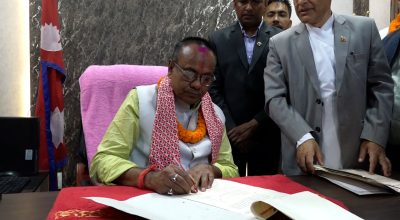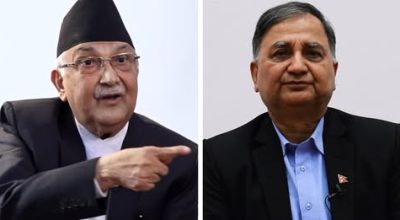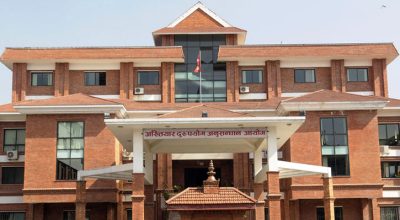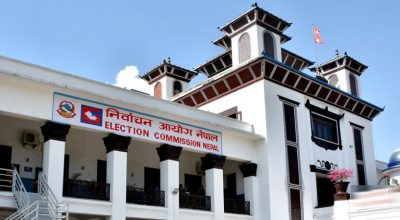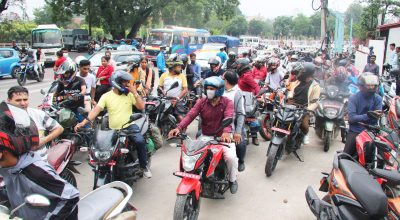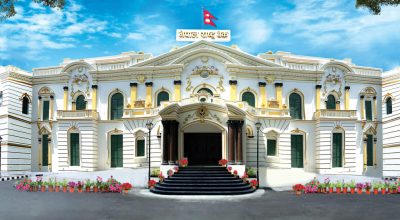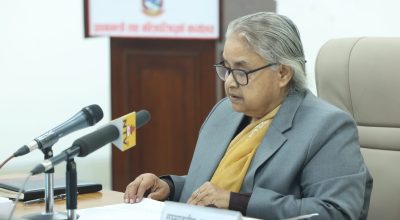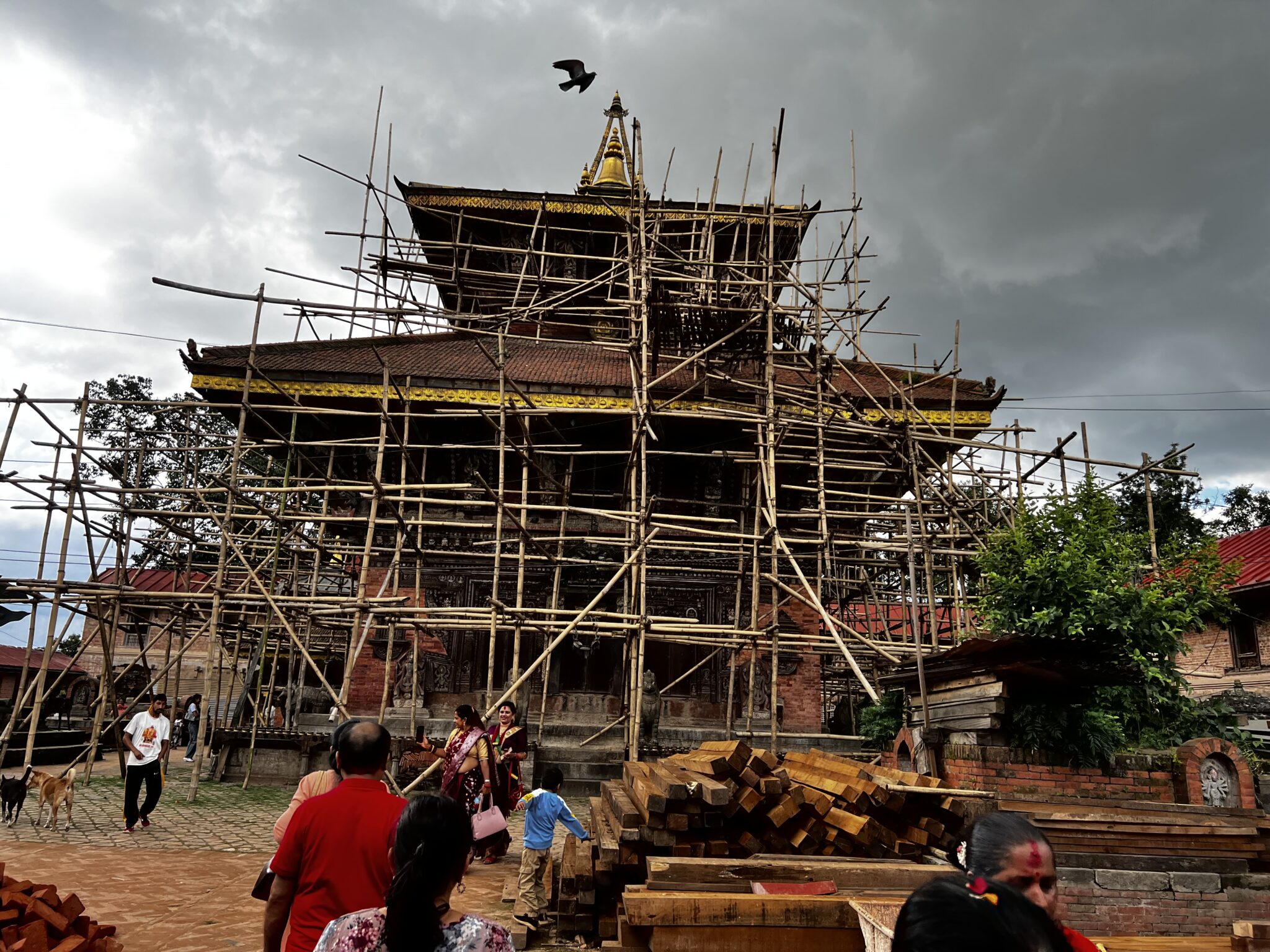
Bhaktapur, Feb 17: Historic Changunarayan Temple, one of the ancient archeological sites of Nepal, has been at high risk due to recurrent landslides and rampant extraction of river materials and soil. It dates back around 2300 years.
Built by the Lichchhavi King Haridatta Burma in 323 BC, the temple sits on a high hilltop known as Changu, around 12 kilometers east of Kathmandu district, and a few kilometers north of Bhaktapur district. The Manohara river runs besides it. The temple has been listed on the UNESCO World Heritage Site in 1969.
According to a history, another Lichchhavi King Mandev during 521 BS ordered the renovation of the temple, the erection of an eagle statue and the setting up of a stone inscription in the temple area. The eagle statue has been inscribed with Lichchhavi words in Sanskrit language. The temple was renovated 323 years ago at the direction of another Lichchhavi King Bhupalendra Malla.
The temple has been at risk of a landslide that has continuously occurred in the eastern and western area. The landslide has advanced towards the shrine of Chandra Surya, one of the nine important shrines of the temple, located in the western area, said the temple priest Chakradhara Nanda Rajopadhyay. The concerned authorities have been apathetic to save the shrine susceptible to a landslide, he accused. “A regular puja is conducted at the shrine. But a landslide risk has been a matter of concern,” he said.
Rampant extraction of river materials from the Manohara river that runs besides the temple, the operation of quarries by cutting small mounds of soil and hills on which the temple sits, and land plotting have put the temple at risk, said the local people. The landslip took place in the area some 20 years ago, and rampant extraction of silts has further put the temple at risk, they said.
The temple has been encroached upon by human as well, said Aruna Nakarmi, chief of the Department of Archeology and the Durbar Care Office, Bhaktapur. Cutting mounds of soil, extraction of river materials and the rampant use of dozers in the area have made the matter worse, she said.
The originality and historic importance of the area has been also eroded by human encroachment on the temple area and surroundings, she said, adding that people have built houses and have been running their business by encroaching on the temple area.
The Department of Archeology has completed the renovation of the temple and its surrounding structures that were destroyed by the devastating 2015 earthquake and aftershocks, and the reconstruction of the sheds in the temple has begun. Devastated by the quake, the temple is supported on poles of wood and bamboo and with the corrugated sheets fencing in a bid to save it from a landslide.
The nearby human settlement has been also at risk of a landslide, said local people. A conch, a Sudarshana Chakra, a spinning, disk-like weapon, and the 108 steps in the west have also faced threatened.
The temple listed on the UNESCO World Heritage Site, the nearby human settlements and the source of drinking water have been at risk, said former lawmaker Prem Suwal.
Concerned about the matter, the local people two years ago filed a complaint with the district administration office, Bhaktapur to stop illegal extraction of soils and silts from the area, but without concrete results so far, he said.
Rampant extraction of river materials and cutting mounds of soil have formed cracks in the lands in the area, according to a study. Each year, many landslides, big or small, have occurred.
Extraction of sediments from the river through a use of heavy equipment used to construct a cricket ground has caused the sinking of the lands, according to a UNESCO study. A geologist of Italy had carried out a study of the Changunarayan area following the quake and handed the report to the Department of Archeology. Landslides had taken place in 16 places, which has further put the area at risk, according to the study. Fragile terrain in the area has put the temple at high risk. The soil here is fragile, silty and loose, according to the study.
To save the area from soil erosion and a landslip, extraction of soil and silts should be stopped at the earliest, the study suggested. Similarly, a bio-engineering technology should be adopted, and retaining walls and gabions constructed. To add to the woes, these suggestions have not been implemented so far. Structures of the temple have been destroyed, and the lands caved in, according to a monitoring by the UNESCO World Heritage Section based on information by geologists and the post-quake report sent by the Government of Nepal.
A landslip in the southern west area has continued since 10 years. Although the Department reconstructed the shed by constructing a concrete wall, extraction of silts below the hills has always been subject to a landslide, thus threatening the temple, said the former ward chair Buddhi Lal Shrestha.
Without conservation, many heritages in the area are at risk of disappearance while some have vanished. As a result, ‘Nau Daha’ is vulnerable, said Nakarmi. Similarly, there are only remnants of most of ‘Shanka Daha’, ‘Dhanacha Daha’, ‘Sinha: Pukhu’, ‘Gwaldaha’, ‘Bandaha’, ‘Tepopungwa Daha’, ‘Ajima Daha’, ‘Phadaha’, and ‘Kali Daha’.
‘Shanka Daha’, which is erected connecting to the main temple, caved in due to a landslide. Although the Municipality allocated budget for the conservation of the Daha, it could not be preserved in its natural state, said the former ward chair Shrestha. Its reconstruction started two years ago cannot move ahead due to various reasons, he said.
Similarly, religious practices and cultural dances including, hymns, festivals, folk musical instruments, have also been vulnerable, said priest Rojopadhyay.
In the past, the area attracted a sizable flow of tourists as well. The Municipality collected thousands of rupees in fees from tourists visiting the area. But, now it has been apathetic to conserve it, he complained.
The rampant use of dozers in the area has caused soil erosion, thus risking the temple, he said. “The temple is vulnerable. On the other hand, heritages here have been registered in the name of individuals. People have registered the lands housing the Malla-era statue in the east of the temple in their name. Similarly, the Malla-era palace in the east, statues and the house of Changunarayan ancestors have been registered in the name of individuals. People have constructed houses and established hotels by encroaching on the temple lands,” he said.
On the matter, the local people launched a signature campaign, and submitted a letter of their signatures to the Department of Archeology and the Guthi office. But, their concerns have remained unheard so far. Instead, the Guthi office said there were no evidences that prove the lands registered in people’s name belong to the Changunarayan temple. Furthermore, it has failed to vacate shops operating in the temple area for years.
The municipality mayor Jiban Khatri said they would be at work to conserve the temple and its historic heritages in the coming fiscal year by making a master plan. “The municipality has limited budget. It is not possible to conserve the big heritages through the limited budget it has. For this, initiatives have been taken to manage required budget from the central and provincial governments,” he said.
There is a need to stop illegal extraction of river materials from the river at the border of Bhaktapur and Kathmandu districts, he said. People have erected houses by dividing lands into plots by destroying small mounds of soil on which the temple sits, he said.
The municipality has also come up with a plan to develop the temple area as a tourist destination alongside its conservation, according to him. RSS





